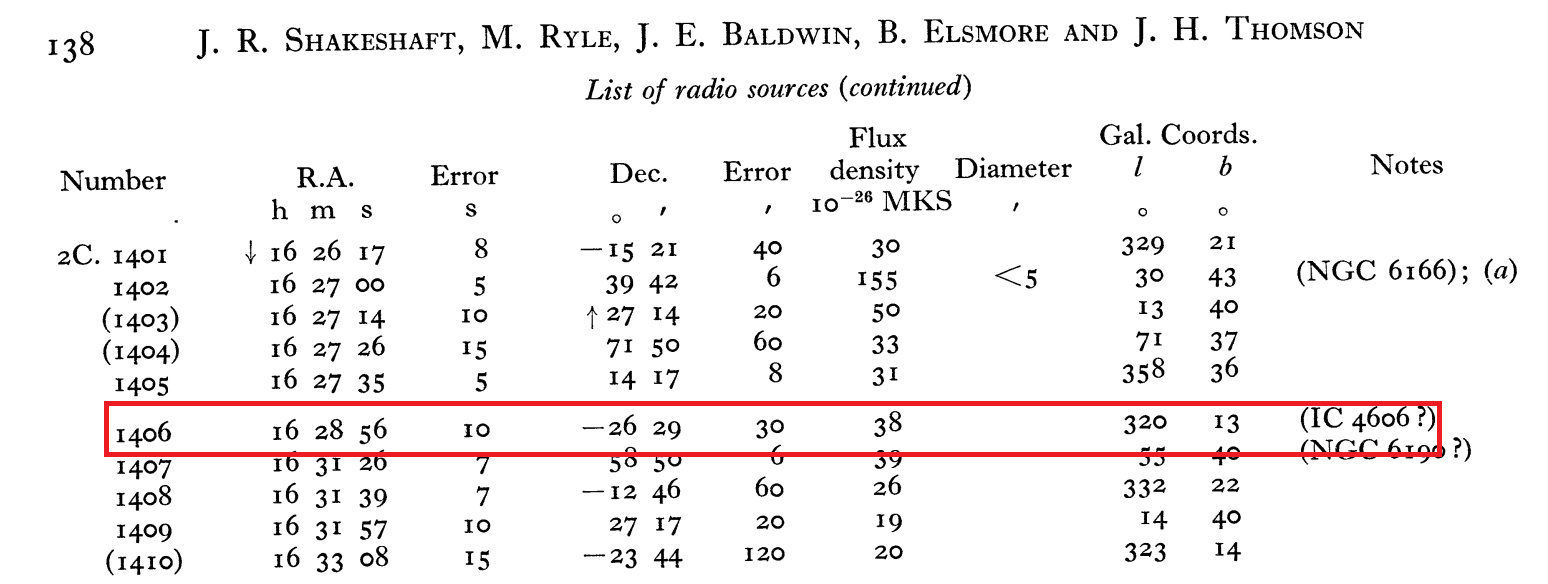I have at least a partial answer to your question:
- I'm doubtful that 2C 1406 corresponds to IC 4606, given the listed flux density.
- IC 4606 is an HII region, rather than a supernova remnant, and knowing the Antares system I feel confident saying it also doesn't correspond to Needham's claimed supernova.
- I don't know what 2C 1406 actually is, although my bet is if it's real, it could well be a quasar. If so, there's no way it would be visible to the naked eye.
I think we can rule out IC 4606 as being associated with the supposed supernova by the simple fact that it's an HII region, composed of ionized gas illuminated by the Antares system, and not a supernova remnant. It's true that we've known about radio emission from Antares, its companion and IC 4606 for about a half century, with detections of Antares at 2.7 GHz in 1971 (Wade & Hjellming 1971) and a "nebulosity" surrounding Antares B at 1.5, 4.9 and 15 GHz a decade later (Hjellming & Newell 1983). Those GHz-range observations indicated flux densities below 10 milliJansky for each of the stars and the above nebulosity (IC 4606?), while the lower-frequency 81.5 MHz 2C data for 2C 1406 lists a much higher flux density of 38 Jy. The nebulosity has a fairly flat spectrum, with a flux density of $S_{\nu}\propto\nu^{-0.1}$, so extrapolating to 81.5 MHz from the ~GHz observations can't get us anywhere near 38 Jy.
We could ask whether the source corresponds to a pulsar, but a quick check of current known pulsars turns up only the famous PSR B1620-26 in the vicinity, not too far away at 16:23:38, -26:31:54. It's a neutron star/white dwarf system complete with an exoplanet, and the neutron star has been spun up again by accreting matter from its companion during its post-main sequence evolution - a sequence of events that would have taken far longer than 3000 years since the neutron star's birth. So that's not a candidate for 2C 1406, either. It's also not a bright source, coming in at 15 mJy at 400 MHz.
The term "radio star" was used quite a lot in the mid-20th century to refer to quasars, which make up much of the Cambridge catalogs. A quasar would of course have no relation to a supernova, and would be far too faint to be seen at optical wavelengths by a human eye. My guess is that 2C 1406 is a quasar, and that the supposed supernova is somewhat coincident with it but completely unassociated. For what it's worth I've been unable to find a known supernova remnant in the vicinity.
We honestly don't even have reason to believe that the event was so close to Antares. A 1962 article by Needham uses the following translation of his cited fragment:
On the 7th day of the month, a chi-ssu day, a great new star appeared in company with Antares.
Given that Antares is the 15th-brightest star in the sky, and even higher on the list of stars visible to Chinese observers, I wouldn't be surprised if "in company" means "a few degrees away from", less precise than what Needham is interpreting it as. Bear in mind, too, that the listed error in the declination of 2C 1406 is 30 arcminutes, which could really place it far from IC 4606.
